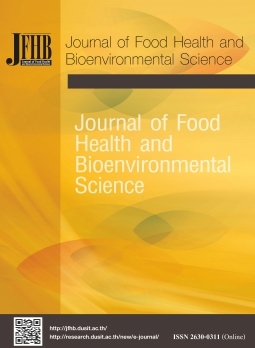The Study of Citrus’s Fibers Production for Power Bar and the Effect on Consumer’s Acceptance
Keywords:
Dietary fiber, Citrus peel, Power barAbstract
This research is a study into the production of citrus fiber from 4 citrus plants: pomelo, tangerines, sweet orange, and limes. Produced dietary fibers were analyzed and the amounts of fiber were found to be 58.21 %, 48.45 %, 44.90 %, and 41.70 % in the pomelo, tangerines, sweet orange, and limes, respectively. According to appropriate material supply, fiber amounts, and the production time, fiber from selected tangerines was added to a power bar product. The ingredients of the power bars were investigated and controlled based on the standard of Acceptable Macronutrient Distribution Ranges (AMDR). The nutrient energy of the power bar was analyzed, and the results showed a calorie ratio of carbohydrate 48.02 %, protein 11.40 %, and fats 40.56 %. These power bars were produced with the amount of citrus dietary fiber being added in the ratio of 5 %, 7 %, and 10%. The result showed that the power bar containing 5 % ratio of citrus’s fiber had average scores for the highest of all aspects. Appearance had an average score of 8.60, color with an average score of 8.66, taste with an average score of 8.73, texture had an average score of 8.46, and finally, overall acceptance had an average score of 8.73. The amount of orange peel added to the energy bar at 7 % ratio and 10 % ratio are different from 5 % ratio with a 95 % confidence in statistics.
References
AOAC. (2016). Official Methods of Analysis (20th ed.). Maryland: Author.
AOAC. (2019). Official Methods of Analysis (21st ed.). Maryland: Author.
Attavanich, N., & Anprung, P. (2003). Dietary fiber powder from Citrus reticulata Blanco peel and its application. Food Journal, 33(1), 45-55.
Bureau of Nutrition. (2020). Dietary Reference Intake for Thais 2020. Bangkok: Author.
Chinnasarn, S., Boriboon, S., & Songpra, P. (2015). Preparation of kumquat residue powder and its application in food. Agricultural Sci. J., 46(3), 557-560.
Constenla, D., Ponce, A.G., & Lozano, J.E. (2002). Effect of pomace drying on apple pectin. LWT Food Science and Tecchnology, 35, 216-221.
Gould, J.M., Jasberg, B.K., & Cote, G.L. (1989). Structurefunction relationship of alkaline peroxide treatment lingnocellulose from wheat straw. Cereal Chemistry, 66, 213-217.
Janluay, K., Sertwittaya, S., Wongmaneeroj, M., & Sertpakdee, R. (2009). The variation species of citrus plants. Retrieved February 7, 2020, from http://www3.rdi.ku.ac.th/exhibition/52/04-plant/kanchana/plant_00.html
Kongkaew, N., Jangsawang, W., Pattanasiri, S., & Malai, D. (2019). Kao-Numpueng pomelo (Citrus grandis L. Osbeck) peel powder used as a fat replacer in chocolate milk ice cream. Agricultural Sci. J., 50 (2), 21-24.
Larrauri, J.A. (1997). Preparation of new types of dietary fibers from tropical fruit byproducts: Properties and uses in dietetic foods (Doctoral dissertation). Madrid, Spain: Universidad Politecnica de Madrid.
Maier, V.P., Bennett, R.D., & Hasegwa, S. (1977). Limonin and other limonoids. In S. Nagy, P.E. Shaw, & M.K., Veldius (Eds.). Citrus Science and Technology Vol. 1 (pp.355-396). Inc., USA: The AVI Publishing Company.
Pichaiyongvongdee, S., & Rattanapun, B. (2014). Dietary fiber prepared from Pomelo albedo which to reduce the bitterness and study on physical and functional properties (Research report). Bangkok: Suan Dusit Rajabhat University Publication.
Saengthongpinit, W. (2008). Production and properties of dietary fiber from Pomelo albedo for food products. In 1st NPRU Academic Conference (pp. 8-14). Nakhon Pathom: Nakhon Pathom Rajabhat University.
Sansawat, T. (2006). Production of dietary fiber powder from orange (Citrus reticulata Blanco) pomace (Master’s thesis). Chiang Mai: Chiang Mai University.
Siwnguan K. (2017). Using of Pomelo albedo powder as dietary fiber in cracker products. PRSU Journal of Science and Technology, 2(1), 14-23.
Sullivan, D.M., & Carpenter, D.E. (1993). Methods of analysis for nutrition labeling. Arlington, VA: AOAC
Tanongkankit, Y. (2014). Utilization of vegetable and fruit residues for production of dietary fiber powder. Journal of Food Technology, 9(1), 31-38.
Watthanataweekul, J. (2002). Fibers for wellness. Journal of Science Service Department, 50(159), 8-31.
Weight Watchers Research Department. (2019). AMDRMacronutrient Ranges and Recommendations. Retrieved February 7, 2020, from https://www.weightwatchers.com/us/blog/food/acceptablemacronutrient-distribution-range.International.
Downloads
Published
How to Cite
Issue
Section
License

This work is licensed under a Creative Commons Attribution-NonCommercial-NoDerivatives 4.0 International License.








